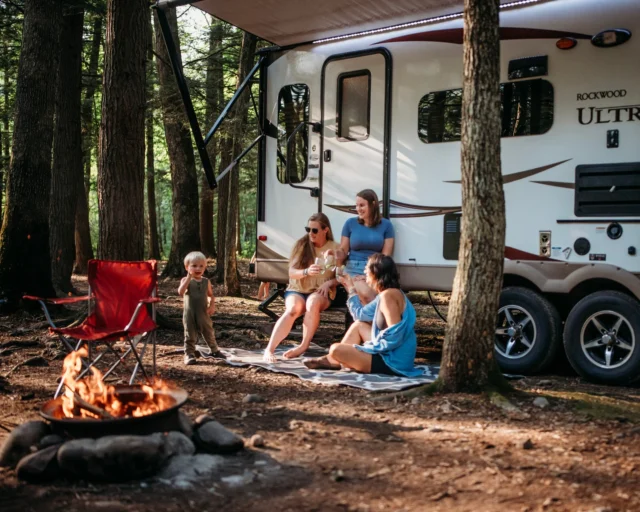
Living full-time in an RV offers freedom and adventure, but it also comes with logistical challenges, one of the biggest being how to receive mail. Whether it’s important documents, packages, or just staying connected with family and friends, full-time RVers need reliable ways to receive their mail while constantly on the move.
Here are some of the best solutions we have found for handling mail while living the RV lifestyle.
1. Mail Forwarding Services
Mail forwarding services are one of the most popular options for full-time RVers. These services provide you with a permanent mailing address and can forward your mail to wherever you are. Many of them also scan your mail, allowing you to read it online.
Popular Mail Forwarding Services for RVers:
- Escapees Mail Service – Designed specifically for full-time RVers, Escapees provides a real street address in Texas, Florida, or South Dakota (which are also popular domicile states).
- America’s Mailbox – Located in South Dakota, this service is ideal for RVers who use the state as their domicile.
- Traveling Mailbox – Provides virtual mail scanning and forwarding, allowing you to manage mail online.
- PostScan Mail & Anytime Mailbox – Private providers that allow users to view and manage their mail remotely, schedule pickups, and forward mail to multiple addresses. Other similar options include iPostal1, USA2Me, and US Global Mail.
- USPS Mail Forwarding Options – For those who prefer a simpler solution, the USPS provides basic mail forwarding services.
How It Works:
- You receive a street address (not just a P.O. box).
- Your mail is collected, and you can choose to have it scanned, shredded, stored, or forwarded to your current location.
- Many services allow you to request specific pieces to be sent when needed.
2. General Delivery at Post Offices

General Delivery is a great, free option for RVers who need to receive occasional mail while traveling. We use it often, especially during the holidays when family and friends send gifts or when ordering items online. It’s simple to use as long as you know where you’ll be during shipping times.
How to Use General Delivery:
- Find a Participating Post Office – Not all USPS locations offer General Delivery, so check in advance by calling or using the USPS Find a Location tool online.
- Address Your Mail Correctly – Use the following format with the address of whichever post office you are utilizing:
[Your First and Last Name]
GENERAL DELIVERY
[Street Address, City, State, ZIP Code]
Example:
John Doe
GENERAL DELIVERY
3632 SMITH AVE
ACTON, CA 93510-9998
- Inform the Sender – Ensure the sender uses the correct address format and ships via USPS, as private carriers like UPS and FedEx sometimes do not deliver to General Delivery.
- Pick Up Your Mail – Bring a valid government-issued photo ID (such as a driver’s license or passport) to the post office. Some locations may require you to request mail at the counter, while others have designated pickup areas.
Things to Consider:
While General Delivery is free and available at many post offices, not all locations offer it, so it’s important to check in advance. Most post offices hold mail for up to 30 days, but high-traffic locations may have shorter time limits, which can be tricky if travel plans change. Many campgrounds charge $5–$10 per package for mail services, making General Delivery a cost-effective alternative. To avoid any issues though, always call ahead to confirm the post office offers General Delivery and verify the pickup details.
3. Amazon Lockers

Amazon Lockers are a convenient way for full-time RVers to receive packages while on the road. These self-service pickup locations are available at various retail stores, gas stations, and shopping centers, making them an excellent option for travelers who don’t have a fixed address.
How to Use and Locate Amazon Lockers:
- Shop on Amazon – At checkout, select “Amazon Locker” as your delivery option.
- Find a Locker Location – Use Amazon’s Locker Finder, search “Amazon Locker near me” on Google or Apple Maps, or enter your location during checkout to see available nearby lockers. Availability may vary based on size and demand.
- Receive a Pickup Code – Once your package arrives, Amazon will email you a six-digit code or barcode.
- Pick Up Your Package – Visit the locker within 3 days, enter the code or scan the barcode, and the locker door will open automatically.
Things to Consider:
- Packages must be picked up within three days before they are returned to Amazon. You can sometimes extend this up to 7 days if you need more time depending on location.
- A benefit of this option is that if you don’t pick up your item within the required time, it will be automatically returned and refunded to your account, making it a convenient option for RVers.
- Not all items qualify for Amazon Locker delivery due to size or weight restrictions. We have run into this on occasion by trying to purchase larger items that wouldn’t fit inside a locker which was a bummer.
- Some locations have an Amazon Counter, where staff at partner stores hold your package for pickup if lockers are full.
- Using Amazon Lockers is an easy, secure, and reliable way for RVers to receive packages while on the move!
4. UPS Store Shipping, FedEx Hold at Location, and Private Mailboxes (PMB) UPS/ FedEx
For full-time RVers, UPS Store shipping and FedEx Hold at Location is another reliable way to receive packages and mail and provide flexible options for temporary, one-time package pickups. These services allow you to have packages shipped to a store or partner location for a fee, typically $5–$10 per package. Always check in advance to confirm the location accepts held packages and inquire about any fees or time limits for pickup. This is a good choice for short-term needs while traveling, as it doesn’t require a monthly commitment.
Private Mailbox (PMB)
A private mailbox (PMB) is a great option for full-time RVers who need a stable mailing address that can receive packages from all carriers. Unlike a P.O. Box, a PMB provides a real street address, making it useful for receiving shipments from UPS, FedEx, and USPS. However, this option is best if you are staying in one area for an extended period, as you’ll need to maintain a physical presence at the mailbox location.
Steps to Get a Private Mailbox:
- Find a Provider – Popular options include UPS Stores, Pak Mail, PostNet, and independent mailbox providers. Search online for “private mailbox near me” or check provider websites.
- Compare Pricing & Services – Costs vary based on location, mailbox size, and services like mail forwarding. Expect to pay $10–$50+ per month, with potential handling fees for packages.
- Complete USPS Form 1583 – The U.S. Postal Service requires this form to authorize the mailbox provider to receive mail on your behalf. You’ll need to present two forms of ID.
- Sign Up & Pay – Once approved, you’ll receive your new mailing address and can start having mail sent there. Many providers even offer mail forwarding services if you’re frequently on the move.
5. Using Family or Friends as Mail Receivers
Having trusted family or friends receive your mail is a flexible and cost-effective option for full-time RVers. They can scan, forward, or hold onto important documents and packages until you can retrieve them. However, this does place responsibility on them, which may not always be convenient, and your mail may not be immediately accessible. Coordination is key—establishing a simple system, like a quick text or call when expecting important mail, can make this option seamless. We’re especially grateful for our family, as most of our important mail goes to their house, and a simple heads-up ensures we get what we need without hassle.
6. Renting a P.O. Box

A P.O. Box at a USPS location can be a viable option if you stay in one area for an extended period. However, it has limitations—most notably, it cannot receive packages from UPS or FedEx. A better alternative is renting a private mailbox from a UPS Store or similar business as stated earlier which provides a real street address and accepts packages from all carriers. If considering this option, compare prices and services to ensure it fits your budget and travel needs.
7. Campgrounds
Using campground mail services can be a great option for receiving mail and packages on the road, but it’s best if you have a clear idea of where you’ll be during the shipment time. Knowing your exact arrival date and duration of stay at the campground is crucial, as mail may be delayed or arrive after you’ve already moved on. Additionally, some campgrounds charge a fee of $5 to $10 per package for receiving and holding mail, so it’s important to factor that into your decision. This service can work well if you have a solid plan for your travel dates and know the campground’s package acceptance policy. However, if your plans are more fluid, alternative options like mentioned earlier may provide more flexibility and fewer fees.
In conclusion
Receiving mail while living full-time in an RV may seem challenging, but with the right approach, it’s completely manageable. From mail forwarding services and General Delivery to Amazon Lockers and campground mail options, there are plenty of ways to stay connected and receive important documents and packages. The key is to plan ahead, choose the service that best fits your travel style, and remain flexible in case of delays or restrictions. By using a combination of these solutions, full-time RVers can keep their mail organized and accessible, no matter where the road takes them.






